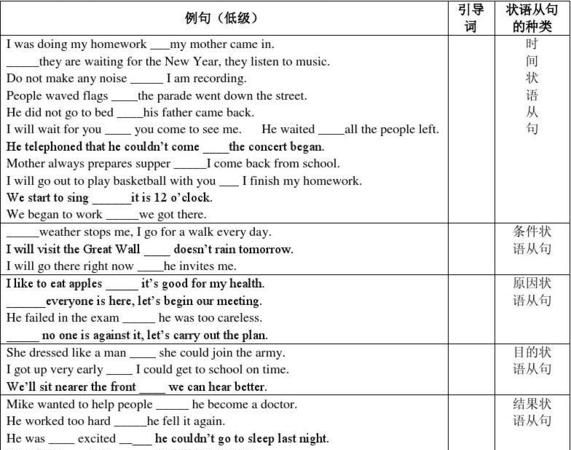本文目录
英语中什么叫状语?请写
Hello!请先看个句子:
I met Mary this morning in the park.
这句话的主干是 I met Mary.我遇见玛丽了。 见面的时间,“this morning”, 就叫时间状语,见面的地点“in the park.”,就叫地点状语。一个句子可以有几个状语。 状语的作用主要是描述动作发生的时间,地点,原因,方式等。
状语的形式有:1.副词: I met Mary again.2.介词短语:I met Mary in the park. 3. 名词短语:I met Mary this morning. 4. 状语从句: I met Mary because I wanted to tell her something.

英语什么是状语 宾语 谓语 定语
状语(adverbial)它是修饰动词、形容词、副词用的。
不定式作状语
1)目的状语
To… only to (仅仅为了), in order to, so as to, so(such)… as to… (如此……以便……)
He ran so fast as to catch the first bus. 他飞快地跑以便赶上第一班车。
I come here only to say good-bye to you. 我来仅仅是向你告别。
2)作结果状语,表事先没有预料到的,要放在句子后面。
What have I said to make you angry.
He searched the room only to find nothing.
3) 表原因
I'm glad to see you.
分词作状语
As I didn't receive any letter from him, I gave him a call.
-> Not receiving any letter from him, I gave him a call.
由于没有收到他的信,我给他打了电话。
时间状语
一般现在时 every …, sometimes, at …, on Sunday,
一般过去时 yesterday, last week, an hour ago, the other day, in 1982, just now
一般将来时 next…, tomorrow, in+时间,
现在完成时 for, since, so far, ever, never, just, yet, till/until, up to now, in past years, always, recently
过去完成时 before, by, until, when, after, once, as soon as
过去进行时 this morning, the whole morning, all day, yesterday, from nine to ten last evening… when, while
将来进行时 soon, tomorrow, this evening, on Sunday, by this time, tomorrow, in two days, tomorrow evening
还有状语从句,就是壮语部分换成句子而已。

在英语中什么叫状语从句
状语是句子的一个重要修饰成分,是谓语里的另一个附加成分,从情况、时间、处所、方式、条件、对象、肯定、否定、范围和程度等方面对谓语中心词进行修饰、限制。
英语状语修饰动词、形容词、副词或整个句子。
状语的作用:状语说明地点、时间、原因、目的、结果、条件、方向、程度、方式和伴随状语等。
状语一般由副词、介词短语、分词和分词短语、名词、不定式或相当于副词的词或短语来担当。其位置一般放在句末,但也可放在句首或句中。
例如:He speaks English very well. 他英语说得非常好。
其中的“very”是程度副词,用来修饰“well”。“very well”是修饰“speak”的程度状语。

扩展资料:
具体用法
1、He came yesterday.(来的时间:昨天)
2、We ate at the restaurant.(吃饭的地点:餐馆)
3、I go to work by car.(去上班的方式:乘汽车)
4、They seldom use the lift.(用电梯的频率:很少)
上例中,作状语的词是介词短语和副词,其实最常见的状语成分就是副词,按照功能的不同,又分为 5 类:时间、地点、方式、程度、频率。
更复杂的状语,是状语从句,即用一个句子描述动作发生的样子,比如:
5、When I got home,the party had begun.(时间状语从句)我到家的时候,聚会已经开始了。
6、I can go where I'd like to go.(地点状语)我可以去想去的地方。
7、Now that everyone has come,let's start.(原因状语) 既然大家都到了,开始吧。
参考资料:百度百科-状语
英语中什么叫做状语
状语用专业定义就是说修饰动词、形容词、副词等的句子成分叫状语,通俗的说就是说明主句状态的句子,比如说When seeing her , I cried.中When seeing her 就是这个句子的状语,说明我是在看到她才哭的,还有He is waiting at the station.中的at the station 就是这个句子的状语,表示他是在车站等待(地点状语)。
副词实际上是一类修饰形容词、动词、整个句子的词,比如说这句话:I very love you.中的very 是修饰动词love的,表示我爱你的程度(非常),还有这句话:I am extremely frightened.中的extremely (极度的) 来修饰形容词 frightened (恐慌的),表示进一步加深的。副词的显著特点就是有ly结尾(sadly、badly等),但是ly结尾的不一定是副词(比如说friendly、likely等)。

以上就是关于英文状语的定义和例句,英语中什么叫状语?请写的全部内容,以及英文状语的定义和例句 的相关内容,希望能够帮到您。

